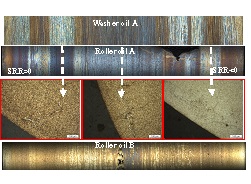RESULTS:
All the tests with oils B, C and D have been suspended while all the tests with oil A have failed prematurely at 70C and 90C (30% of estimated life at 90C). WECs have been observed only in rollers tested with oil A regardless the position across the raceway, with a typical a top-down growth in the direction of over-rolling.

Fig. 2 – Typical results obtained for oil A and oil B at 90C: WECs only observed in rollers for oil A both at 90C and 70C.
DISCUSSION:
Wear assessments, roughness measurements and extra component tests suggest the rollers and washers are subject to comparable mechanical stresses and shear stresses both for oil A and B. This suggest that the oil formulation may reduce bearing performance by weakening the bearing steel. As expected, the topography and chemical composition of the reactions layers are different for each oil. However, no direct correlation could be identified between basic reaction layer properties and WECs, for example comparing reaction layers on rollers and washers for oil A (at 90C and 70C) (Fig. 2). Finally, no direct correlation with the frictional energy accumulation as proposed in [3] could be confirmed in those tests. Further tests and investigations are now being considered.
REFERENCES:
[1] Stadler, K., Vegter, R. H., and Vaes, D., 2018, “White Etching Cracks - a Consequence, Not a Root Cause of Bearing Failure,” SKF Evol., 1(January), pp. 21–29.
[2] Richardson, A. D., Evans, M.-H., Wang, L., Wood, R. J. K., Ingram, M., and Meuth, B., 2018, “The Evolution of White Etching Cracks (WECs) in Rolling Contact Fatigue-Tested 100Cr6 Steel,” Tribol. Lett., 66(1), p. 6.
[3] Franke, J., Carey, J. T., Korres, S., Haque, T., Jacobs, P. W., Loos, J., and Kruhoeffer, W., 2017, “White Etching Cracking—Simulation in Bearing Rig and Bench Tests,” Tribol. Trans., 0(0), pp. 1–11.
[4] Paladugu, M., Lucas, D. R., and Scott Hyde, R., 2018, “Effect of Lubricants on Bearing Damage in Rolling-Sliding Conditions: Evolution of White Etching Cracks,” Wear, 398–399, pp. 165–177.
[5] Gutiérrez Guzmán, F., Oezel, M., Jacobs, G., Burghardt, G., Broeckmann, C., and Janitzky, T., 2017, “Reproduction of White Etching Cracks under Rolling Contact Loading on Thrust Bearing and Two-Disc Test Rigs,” Wear, 390–391(May), pp. 23–32.
[6] Richardson, A. D., Evans, M.-H., Wang, L., Wood, R. J. K., and Ingram, M., 2018, “Thermal Desorption Analysis of Hydrogen in Non-Hydrogen-Charged Rolling Contact Fatigue-Tested 100Cr6 Steel,” Tribol. Lett., 66(1), p. 4.